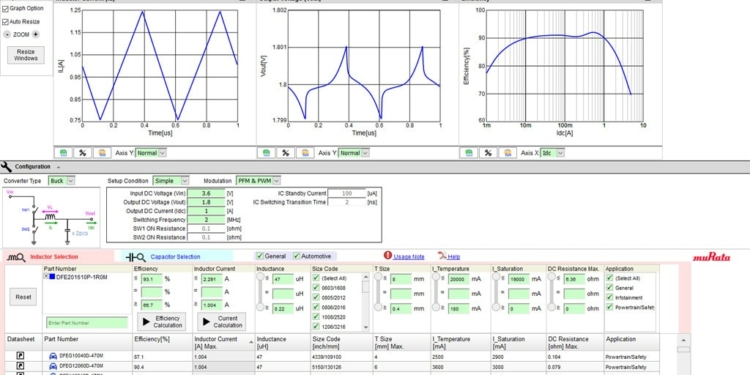Source: Murata news
Nagaokakyo, Kyoto Prefecture, Japan, September 21, 2018 – Murata today announced that it has integrated a DC-DC converter design inductor/capacitor selection support tool (DC-DC converter tool) into its SimSurfing power circuit design support software. Additionally, a noise filter selection support tool (noise filter tool) is scheduled to be incorporated by end of September.
SimSurfing is an online-based power circuit design support software tool that supports circuit designers and component engineers. Using SimSurfing, the optimal components can be selected quickly and easily by visually checking graphs that represent the impedance, transmission, and reflection characteristics of various Murata products such as capacitors, inductors and EMI suppression filters (ferrite beads and common mode choke coils). The software can be accessed free of charge on the Murata website: https://www.murata.com/tool.
Given that both of these tools are online, the component characteristics of new Murata products will be immediately included in the SimSurfing library. This allows engineers to select optimal components from the latest DC-DC converter and noise filter solutions. Moreover, to make more advanced design capabilities possible, Murata also incorporated a wealth of design guidance developed over many years.
Features of the New Tools
DC-DC converter design inductor/capacitor selection support tool
DC-DC converters are composed of many types of power inductors and capacitors. This makes it difficult to select suitable components that create highly efficient DC-DC converters meeting specific requirements. In many cases, the actions involved in configuring a DC-DC converter cannot be ascertained until the circuit has actually been configured.
Indicators used to evaluate the performance of DC-DC converters include a) efficiency*1, b) ripple current*2, and c) load transient response characteristics*3. In the past, analyzing these indicators took long hours of advanced technology analysis using proprietary software.
The new DC-DC converter tool is equipped with a function that enables the high-speed simulation of DC-DC converter behavior. The tool performs high-speed analysis and representation of the actions and performance of DC-DC converters (a-c above) by inputting the minimum parameters such as the input and output voltages, switching frequency, inductance and capacitance. This makes it easy for an engineer to select optimal inductors and capacitors for the task at hand, resulting in a substantial shortening of the overall design time.
This DC-DC converter tool is compatible with a wide range of applications including equipment for automotive and smartphone use. In addition, Murata incorporated a wealth of database information and measurement know-how on power inductor loss for DC-DC converters.
*3 c: The analysis function for load response characteristics is scheduled to be added in 2019.
Noise filter selection support tool
In general, noise filters are made up of complex combinations of inductors, capacitors, ferrite beads and common mode choke coils. Filter circuits are designed with impedance peaks set at multiple frequencies. During the conventional design process, it is difficult to specify the filter types (element configuration) and the constants for each element. Furthermore, it takes time to perform analysis on design circuits because of the need for engineers to obtain the characteristic data for multiple devices from component manufacturers, load this data and then conduct simulations.
This new noise filter tool leverages abundant noise countermeasures know-how developed over many years. With this new tool, engineers can freely select and combine inductors, capacitors, ferrite beads and common mode choke coils with various characteristics and analyze noise filter circuit characteristics for any desired frequency, while also analyzing losses in both the common mode and the differential mode. In addition, it supports the design of circuitry corresponding to “CISPR25,” the international standard used for circuit protection from noise externally radiated by automotive electronic components.
Product website
DC-DC converter design inductor/capacitor selection support tool can be found at: https://ds.murata.co.jp/mpst/. The link to the noise filter selection support tool will be announced by end of September
Explanation of Terms
*1 Output power ÷ input power
*2 A pulsation component included in direct current
*3 The response characteristics of the output voltage in response to fluctuations in the load current































